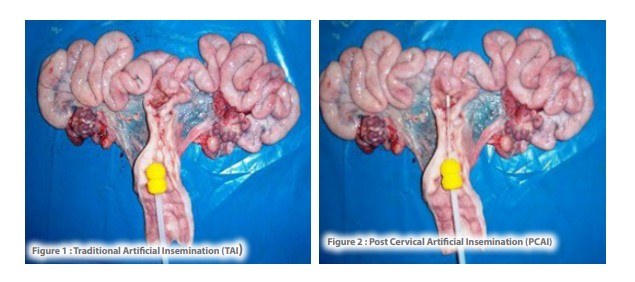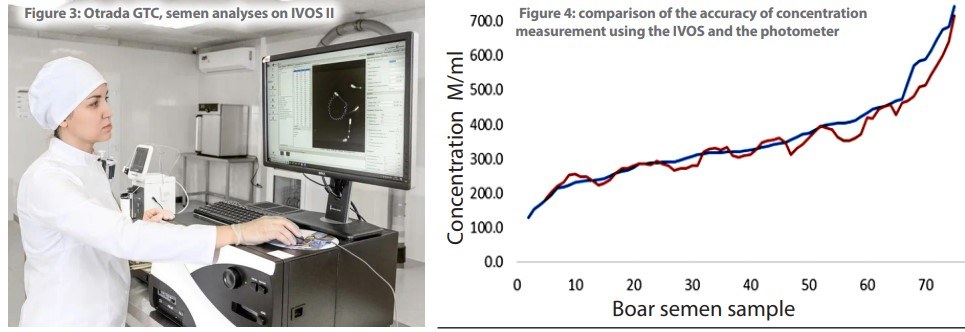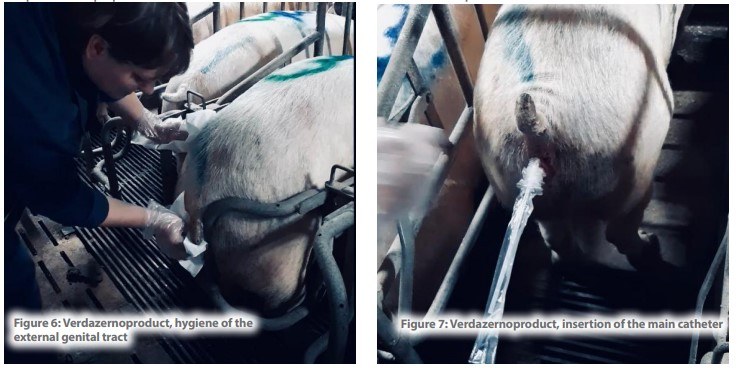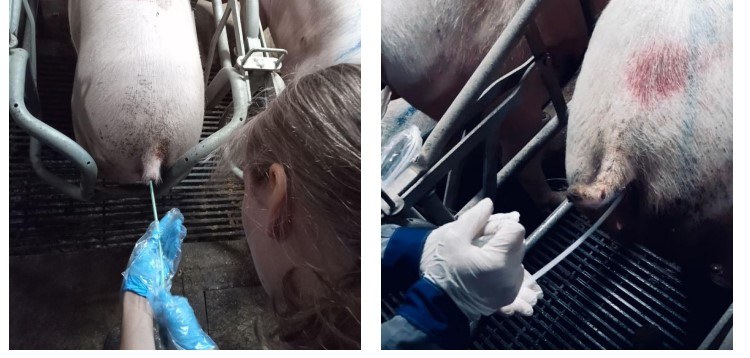
18.03.2024
Traditional artificial insemination (AI) Introduces a sperm dose into the caudal part of the cervix. Using this technology, 2.5 to 3 billion spermatozoa must be diluted in a large volume of media (70-90 ml). Often, when using AI, semen leakage is observed (about 20% back-flow), and the insemination time for one sow takes from 3 to 5 minutes.
The semen concentration, and the dose volume, can affect the efficiency of the use of boars. An intentional decrease in the concentration of spermatozoa in a dose leads to an increase in the number of doses produced by one boar. This leads to significant savings in boar management and allows high-index boars to serve more sows, accelerating the herd’s genetic progress.
Post-cervical artificial insemination
Post-cervical artificial insemination (PCAI) is a technology in which a sperm dose is injected directly into the body of the uterus, after the cervix. PCAI in swine was discovered in 1980, but it has only become widespread in the last ten years.
PCAI technology allows the sow to be inseminated with a smaller dose volume (35–50 ml) and sperm quantity (1.0–1.5 billion per dose). In addition, PCAI will significantly reduce the insemination time per sow, as it does not require stimulation of the sows by the boar during the insemination process. Additionally, PCAI also facilitates insemination with decreased backflow.

PCAI benefits
The efficiency of using boars can be determined by the number of sows needed per 1 boar, and the number of boars needed to mate 10,000 sows (Table 1). The transition from natural mating to TAI can reduce the number of boars by up to 90 %. The change from TAI to PCAI technology (1.5 billion or 900 million spermatozoa) reduced the number of boars by another 50 -70% depending on desired sperm concentration in doses.

Since one terminal boar costs approximately 3,000 € and its recommended replacement is 75–100 % per year, PCAI technology can reduce production costs per 10,000 sows by 60,000 to 100,000 €per year. This will also affect the cost of a dose. On average, a standard dose costs 4 €, of which about 50 % is the depreciation for boars. Accordingly, the higher the efficiency of the boar is, the lower the cost of one sperm dose. Expenses incurred by artificial insemination centers (AIC) are outlined in (Table 2).

In addition, the main factor in the popularity of PCAI technology is the acceleration of the herd’s genetic progress. By switching to PCAI, we can produce a greater number of doses from a high-index boar, increasing the number of piglets with more desirable characteristics, such as carcass quality, growth, feed conversion, etc.
Reducing the time of insemination will also make it possible to distribute the employees’ work more rationally. With traditional insemination, the inseminators spend 3 to 5 minutes per sow. PCAI can be reduced to one minute, and inseminators can devote the remaining time to other necessary activities.
Necessary steps for a successful introduction of PCAI
With a decrease in the volume and concentration within the dose, a qualitative ejaculate analysis plays a significant role. Accurate calculation of motility, concentration, and analysis for morphological defects using Computer Assisted Sperm Analysis (CASA) using formaldehyde or staining the sample with eosin blue is required.
The variation of ejaculate analysis using a photometer and a microscope can reach 10-15 % since the photometer estimates the concentration based on the radiation flux method with a given spectral sensitivity. Additionally, conventional microscopy analyses can be very dependent on the human factor. Research on morphological defects is often not done or analysed inaccurately in line production.
Reducing the concentration to 1-1.5 billion per dose with a 10-15 % variation can lead to the preparation of doses with an unacceptable or under-estimated threshold number of spermatozoa per dose. This can negatively affect production performance.
In this case, using a CASA such as IVOS II or CEROS II will significantly reduce the time of analysis, the risk of subjective assessment of the laboratory assistant.
PCAI Recommended Protocol
Use test boars to detect heat. Sows in heat show several signals: ears and tail up, the head is turned towards the boar, the vulva is enlarged and hyperemic, and during staff's stimulation, it bends the back. The primary signal of heat is the posture of immobility when the staff pushes on the back or performs the pose of a rider.
 Mark the sows in heat and let them rest for at least 15-20 min. After stimulation, sows get an oxytocin peak that lasts 10 to 15 min. At this time, the muscles of the internal genital organs contract, which makes it difficult to insert the intrauterine insert.
Mark the sows in heat and let them rest for at least 15-20 min. After stimulation, sows get an oxytocin peak that lasts 10 to 15 min. At this time, the muscles of the internal genital organs contract, which makes it difficult to insert the intrauterine insert.
Insemination with the PCAI technique should occur during the oestrus refractory period, which begins 15 minutes after stimulation and lasts approximately 40 and 60 minutes. Work with a group of 5 sows. Thoroughly clean the external genitals with a dry disposable paper towel and insert the main catheters. Repeat this for the four next sows. 
Afterward, return to the group’s first sow and insert the intrauterine inner catheter. The inner catheter should slide in easily and without obstruction. If everything is ok: take the dose from the climate box, homogenize it, and connect it to the catheter. Slowly, using an air cushion or by twisting the bag, squeeze the dose into the body of the uterus.
If the intrauterine inner does not pass through the cervix and resistance is felt, move on to the next sow, and return to the previous one later.
After insemination, gently remove the intrauterine catheter and the main catheter with a rotating motion to stimulate the cervix further to contract. During the introduction of PCAI technology in a farm, a proper protocol and thorough staff training play a vital role. Otherwise, it may negatively affect the level of production indicators and the farm’s profit. 
Frequently Asked Questions
1 - Why 24 hours between two PCAI?
In the reproductive tract, inseminated spermatozoa will undergo capacitation to become capable of fertilization. After this time, sperm will remain viable in sperm reservoirs near the utero-tubal junction of the female reproductive tract, awaiting ovulation, for up to 16-18 hours. A second insemination can be timed 20-24 hours after the first, allowing for constant availability of capacitated sperm during the ovulation period.
2 - Can I move sows, and when?
It is best not to move the sow after AI. This is a stress factor for the animal and can disrupt fertilization. If necessary, you can move a sow at least 24 hours after the last insemination.
3 - What if I cannot insert an intrauterine catheter?
Patience, skip this sow. Then come back in a few minutes. If the second time does not work out, pull out the inner catheter and inseminate using TAI.
4 - Do you recommend using lube?
Yes, but make sure this product is non-spermicidal.
5 - Is there a difference in the PCAI technology for first-cycle sows?
Yes, it may take more time and attention than with second-cycle sows and older. The reproductive tracts of sows of the first cycle are larger than those of gilts but shorter than second-cycle sows. Some sows take longer to relax the cervix. Also, due to the smaller reproductive tract, some sows will not accept the entire length of the intrauterine insert to the “back wall” of the main catheter.
6 - Can the PCAI technology be applied to gilts?
It is possible if the production has been working with PCAI for the sows and has stable high performance. Introducing PCAI for gilts requires a different work protocol and additional staff training by a specialist.
7 - What to do if there is a reverse outflow of semen between the insert and the main catheter?
Check the quality of the lock between the main catheter and the cervix; most likely, there is none. Pulling out the catheter and performing insemination again with a new catheter and dose is necessary.
8 - The sperm dose is not squeezed out. What can I do?
If there are difficulties with the dose, then the intrauterine insert should be checked. It is either bent or placed right next to the uterine wall, which may have caused an obstruction.
Summary
The introduction of PCAI is getting more popular every year as farmers seek to increase production efficiency while reducing costs. In addition, PCAI technology will help optimize work in times of staff shortages on the farm.
If this technology is of interest to you, please contact our representative in your region or by email at contact-imv@imv-technologies.com
